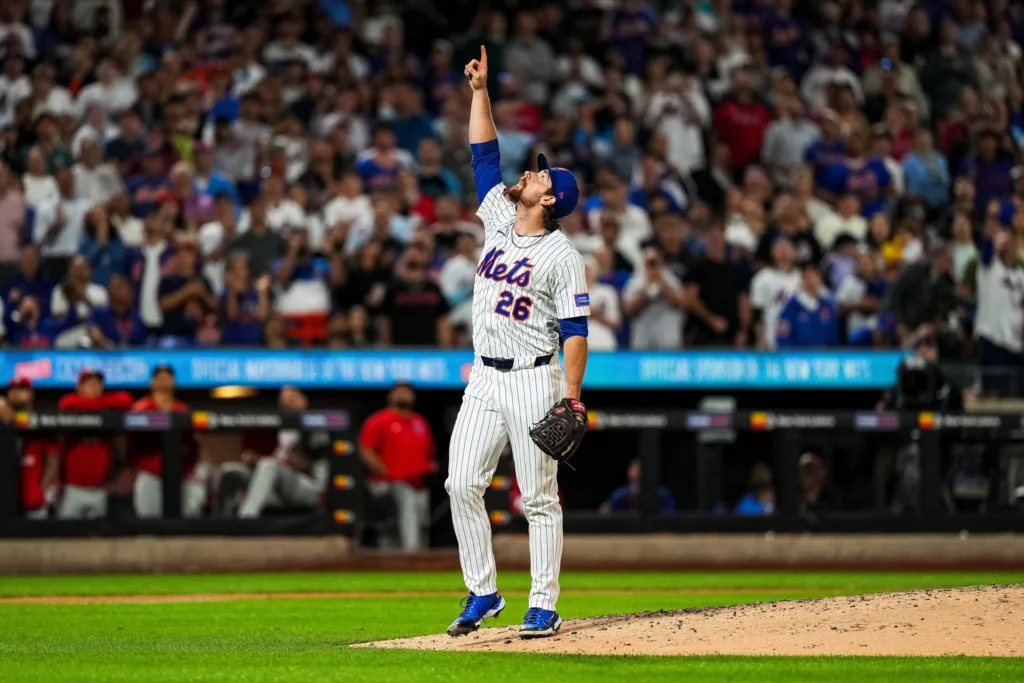The Mets felt good about the state of their minor league system in spring training, good enough that they felt they could be poised for a banner year on the farm in 2025.
“Anecdotally, one of the first signs of a good year was during spring training,” Mets farm director Andrew Christie said. “Our position players were giving us feedback that, once they started playing the other teams in Florida, they felt way more prepared because of how nasty our pitchers were.
“Our pitching excellence has been building for some time now, and the stuff and execution in spring training was phenomenal. As is typical, our hitters were a bit behind the pitchers in spring, but we felt very confident we’d have a ton of pitching success.”
As of Sept. 14, Mets minor league affiliates had the fifth-highest winning percentage this year and, in fact, had allowed the fewest runs per game among all organizations. This is a stark contrast from recent seasons. Mets affiliates ranked 25th and 26th in winning percentage in 2023 and 2024.
Focusing solely on full-season affiliates, the Mets’ four clubs have the second-best winning percentage among organizations this season, trailing only the Tigers.
Three Mets affiliates—Double-A Binghamton, High-A Brooklyn and Low-A St. Lucie—qualified for the playoffs with first-half division championships. Binghamton and Brooklyn set single-season franchise records for wins. Triple-A Syracuse finished with its first winning record since 2019 and just the fifth winning record for a Mets Triple-A affiliate this century.
The Mets haven’t had three full-season playoff teams in one season since 2013 and 2014, back when players including Jacob deGrom, Zack Wheeler, Brandon Nimmo, Jeff McNeil, Michael Conforto, Noah Syndergaard and Steven Matz were prospects.
This group of players who won together in the minor leagues later contributed to the Mets winning the National League pennant in 2015 and a wild card in 2016.
Leading the prospect charge this time around are righthanders Nolan McLean, Jonah Tong and Brandon Sproat, all of whom made their MLB debuts late this season and are making key starts in a playoff race.
Position prospects poised to potentially help the 2026 team include outfielders Carson Benge and A.J. Ewing, shortstop Jett Williams, third baseman Jacob Reimer and first baseman Ryan Clifford. All five finished the season at either Double-A or Triple-A.
“We collectively feel that winning is a huge part of player development,” Christie said. “It is generally indicative of the quality and depth of your system if you can win games, especially if the players are age appropriate—or younger—for the level.
“Winning is a skill, and learning how to do it in the minor leagues is something we hope to continue to drive home for our group. Development of each player’s individual baseball skills remains our top priority, but if we are doing that well, winning should follow.”
While the standard for every organization is to develop players while winning games in the minor leagues, it requires talent, depth and players who are bought-in on improving.
It’s also a standard reached only intermittently by the Mets in their history. The Mets of the early-to-mid 2010s, led by Sandy Alderson and Paul DePodesta, are one example. The 1980s Mets, led by Frank Cashen and Joe McIlvaine, were BA Organization of the Year in both 1983 and ’84 and won the 1986 World Series.
Now, president of baseball operations David Stearns and his scouting and player development teams are in the process of cultivating a farm system that can set the MLB team up for future success.
Two of Stearns’ first hires when he took the reins in November 2023 were Andy Green as senior vice president of player development and Kris Gross as VP of scouting. Green and Gross have headed the minor league system and the draft in each of the past two seasons.
But many of the Mets’ key prospects were in the organization at the time Stearns took over. So, too, were two key PD executives: director pitching Eric Jagers and director of hitting Jeff Albert, both hired in November 2022.
“The word I use is ‘alignment,’” Albert said. “We have good interactions between scouting and player development, where both Eric (Jagers) and I have been involved in the draft. I felt great about being included in the process.
“There’s good communication across departments. It’s something I think we pay attention to. I think we have really strong leadership in each area, in each department.”
A Culture Of Continuous Improvement
Christie referred to Mets minor league pitchers as “nasty.”
The numbers spell out their dominance. Mets pitchers in full-season leagues compiled the highest strikeout rate (26.5%), lowest opponent average (.220) and best K-BB% (15.7) among all organizations this season. Their 3.66 ERA ranks neck-and-neck with the Tigers for the top spot. The Binghamton and St. Lucie pitching staffs led their leagues in ERA, while Brooklyn ranked second.
While MLB-contributing prospects such as McLean, Tong and Sproat are key drivers of that system-wide dominance, the Mets saw outstanding results from age-appropriate pitchers up and down their system.
One benchmark of developmental success is a large number of players who are performing in leagues in which they are no older than the average player. With that in mind, I’ve estimated the wins above average (WAA) compiled by age-appropriate pitchers in full-season leagues this season. I calculated each pitcher’s FIP and adjusted for home ballpark, then converted their runs above average into WAA by way of the runs-per-win estimate for each league. No pitcher older than level average counts toward the total.*
Here are the top 10 organizations in terms of pitching WAA by age-appropriate players at full-season levels:
pitchinga(21U)A+(22U)AA(23U)AAA(24U)Total WAAMets1.01.76.71.711.1Blue Jays0.26.3-0.2-0.36.0Marlins-1.52.43.41.15.4Tigers2.80.1-0.31.13.7Athletics1.30.22.4-0.83.1Yankees-1.93.71.6-0.43.0Cardinals-0.1-2.04.40.62.9Red Sox-1.61.41.70.92.4Cubs0.60.50.90.42.4Orioles-1.21.23.1-0.82.3
Mets pitchers compiled the highest overall wins above average total at 11.1 and nearly doubled up the No. 2 Blue Jays. The Mets had the highest WAA total at both Double-A (Tong, Jack Wenninger, Zach Thornton, Jonathan Santucciand others) and Triple-A (mostly McLean and Sproat) and had positive values at both Class A levels.
“For me, it’s our entire group bearing the fruits of the labor,” Jagers said. “We’ve worked to instill a culture of continuous improvement and challenged our guys to get a little bit better each day. We’ve been encouraged with the calibration across levels, spanning from the major leagues down through our Dominican academy. It’s a huge testament to our staff. The coaches have all done a great job documenting individual development processes, making level-to-level transitions pretty smooth.
“We’ve also seen strong participation in our offseason camps. It’s been awesome to see our older players being willing to invest in and spend time with the next generation of Mets.”
As for developing, expanding and completing pitchers’ repertoires, the Mets, like most organizations, take a proactive approach.
“Often we have information on pitches that will tell us how effective they shouldbe before they are thrown versus hitters in a game, and we do not hesitate to use that information to make guys better right away,” Christie said. “Our job is not only to make our pitchers better, but also to do it as quickly as we feel we are able to.”
McLean is a classic case in point.
Drafted in 2023, he entered pro ball as mostly a four-seam fastball and slider pitcher. The Mets raved about the quality of stuff he showed at their pitching lab in Port St. Lucie, Fla. The issue for McLean at that time was that he was used primarily as a reliever at Oklahoma State—where he was a two-way player—and that his control and command were shaky.
As McLean progressed and began focusing solely on pitching midway through 2024, he added a sinker and curveball that have become go-to pitches. He also developed a cutter and changeup to keep lefthanded hitters guessing. In his third MLB start, he drew at least one whiff on six different pitch types as he tossed eight shutout innings at home against the Phillies.
Sproat made a similar adjustment to his mix when he hit a wall at Triple-A early this season. Lefthanded batters were getting the better of him, so he began throwing more four-seam fastballs, curveballs and changeups while downplaying his sinker and sweeper. His platoon split improved, and he won International League pitcher of the month honors in July before making his MLB debut in September.
Double-A Binghamton pitching coach Dan McKinney observes that many Mets pitching prospects make a developmental leap in year three of their professional careers. That holds true for 2022 seventh-rounder Tong, who burst on the prospect scene in 2024, and for 2023 draft picks McLean and Sproat, both of whom dominated Triple-A in 2025 en route to making their MLB debuts. Fifth- and sixth-rounders Zach Thornton and Jack Wenninger from that 2023 draft also turned in their best work this season.
If the year three trend holds, then 2024 picks like second-rounder Jonathan Santucci, seventh-rounder Will Watson and 13th-rounder R.J. Gordon could be poised for big things next season.
The Mets are generating pitching value from all rounds of the draft—not one of the aforementioned pitchers was drafted higher than the second round—which is a sign of an organization with a healthy pitching development plan.
Playing To Their Strengths
If you filter the FanGraphs minor league leaderboard for batters with at least 400 plate appearances and sort by wRC+, six Mets hitters surface among the top 50 or so names, led by third baseman Jacob Reimer, outfielder Carson Benge, outfielder A.J. Ewing, catcher Chris Suero, first baseman Ryan Clifford and shortstop Jett Williams.
The Mets’ core position prospects are both productive and young. Benge is the oldest member of the group at 22 years old. This combination of production, proximity and youth contributes to the Mets having one of the top wins above average totals for age-appropriate position players in the full-season minor leagues.
Here are the top 10 organizations in terms of estimated batting WAA among age-appropriate full-season minor league players:
battinga(21U)A+(22U)AA(23U)AAA(24U)TOTal waaTigers**-0.511.22.70.513.9Mets-2.82.68.01.29.0Cubs1.20.30.06.58.0Dodgers4.75.1-1.2-1.17.5Pirates0.58.30.3-2.17.0Mariners0.21.81.03.16.1Yankees0.42.2-0.63.55.5White Sox0.83.1-0.71.74.9Twins-7.02.48.5-0.43.5Reds3.5-6.91.93.11.6
Batting production is based on wOBA and is park adjusted. Neither fielding quality nor position value are considered. This is merely an assessment of batting production.
Mets affiliates play in pitcher-friendly parks, so what those venues giveth to pitchers they taketh away from batters. As a result, Mets full-season hitters rank ninth with 4.84 runs scored per game***, with notable showings for strikeout rate (22.4%, fourth lowest) and stolen bases (836, seventh highest).
Another commonality among the Mets’ top position prospects is their versatility—and not simply the type of versatility forced on prospects when they reach the upper levels and MLB team needs come into focus.
Each of the six spotlighted players—Reimer, Benge, Ewing, Suero, Clifford and Williams—has appeared in at least 10 games at multiple positions. All but Reimer have appeared in at least 10 games at three or more positions. Ewing and Williams play both middle infield and outfield. Suero is a catcher who is a credible defender at first base and in left field.
“We have a strong belief in positional versatility, and that naturally extends to our system,” Christie said. “You can see it reflected at the major league level with guys like Jeff McNeil, Brett Baty, Ronny Mauricio and Mark Vientos playing in different spots to help the team win. We instill in our prospects that the ability to play in multiple spots will only help them get on the field at the highest level.”
True positional versatility requires a focus on perhaps the least-appreciated tool: players’ throwing arms.
“Arm care and improving arm strength is a point of emphasis and is something we feel position players have undervalued in the past,” Christie said. “Another broad initiative that we have pushed is raising our players’ awareness overall, specifically of their strengths. Andy Green has preached that we will win by ‘raising awareness and transferring ownership’ to our players.”
Just like a pitcher will lean into his best pitch to achieve results, Mets hitting prospects will lean into their top traits. For a player like Vientos, that trait is power, much as it is for Reimer and Clifford. For 2025 rookie Luisangel Acuña, those traits are selectivity, zone contact and speed, just as they are for Ewing, Williams and Double-A center fielder Nick Morabito.
“The truth is that, in year one, you’re learning the player,” Albert said. “In year two, you’re seeing some of those improvements but with less consistency. In year three, hopefully you’re seeing that player taking ownership and making adjustments on his own.
“We want to see that happen on the minor league side. It might happen in one year or three or five, but we want to transfer that skill and ownership to the player.”
According to Christie, the Mets’ development plans would not get the desired results if the players weren’t committed to working and improving and being good teammates.
“Those character traits allow them to reach the ceiling we envision for them,” he said. “That is also a massive credit to our scouting department over the past number of years in scouting the entirety of the player, not just the baseball skills.”
* The average age by level is defined as 21-and-under at Low-A, 22U at High-A, 23U at Double-A and 24U at Triple-A.
** The Tigers’ total is driven by its frontline trio of Kevin McGonigle, Max Clark and Josue Briceño along with strong seasons from Izaac Pacheco, Max Anderson and others.
*** Many of the top run-scoring organizations have affiliates in the hitter-happy California and Pacific Coast leagues, including the Dodgers, Mariners, D-backs, Giants and Athletics.
Discover more from 6up.net
Subscribe to get the latest posts sent to your email.


